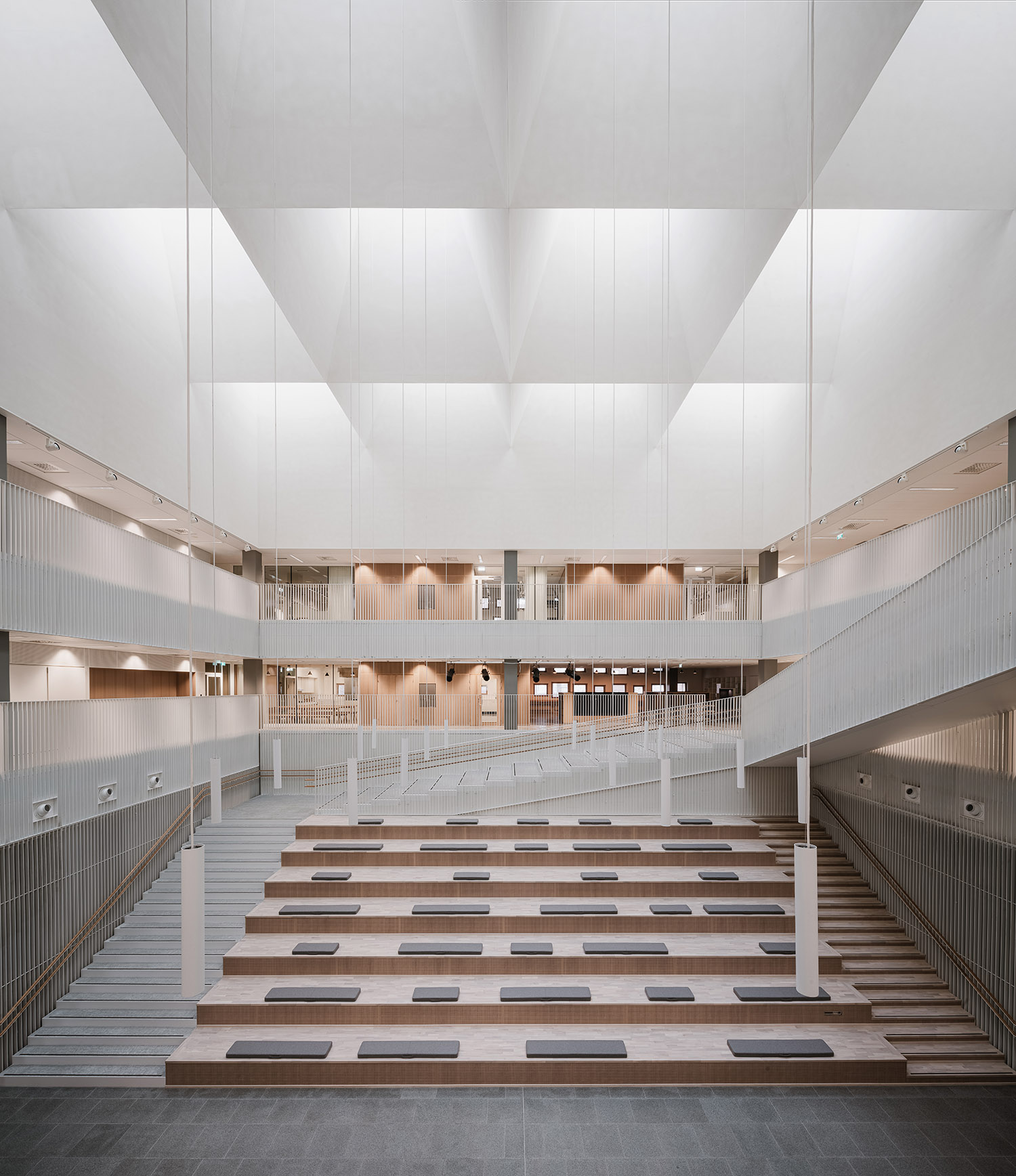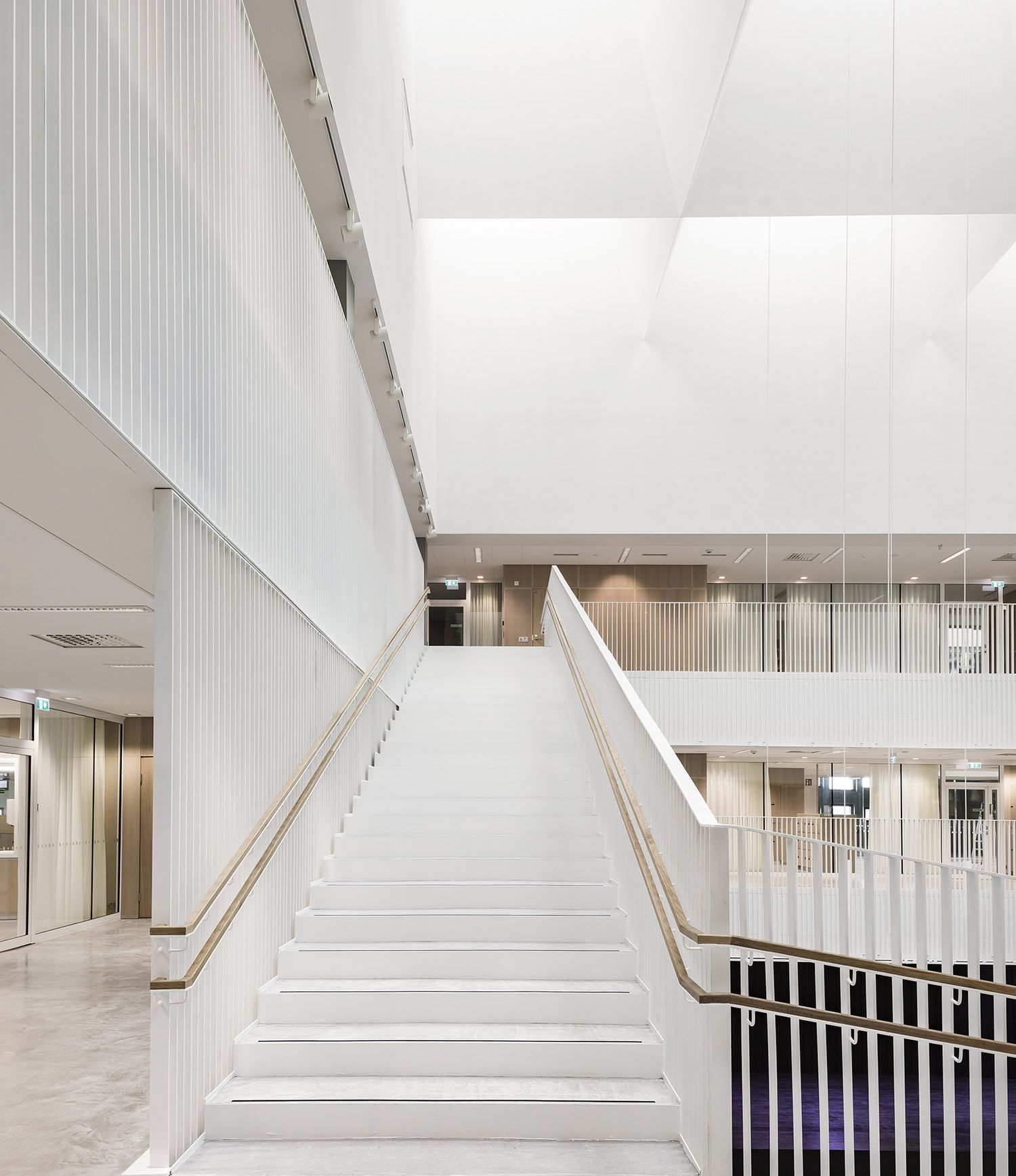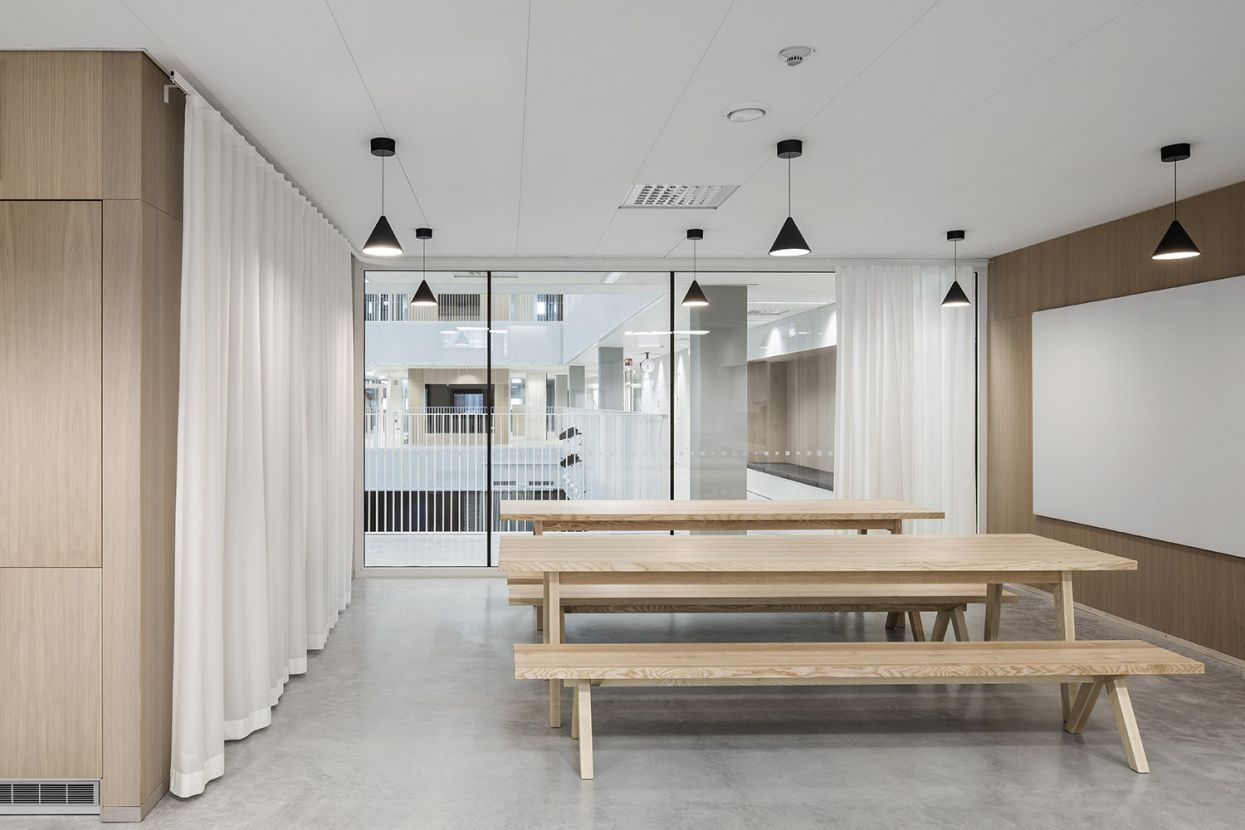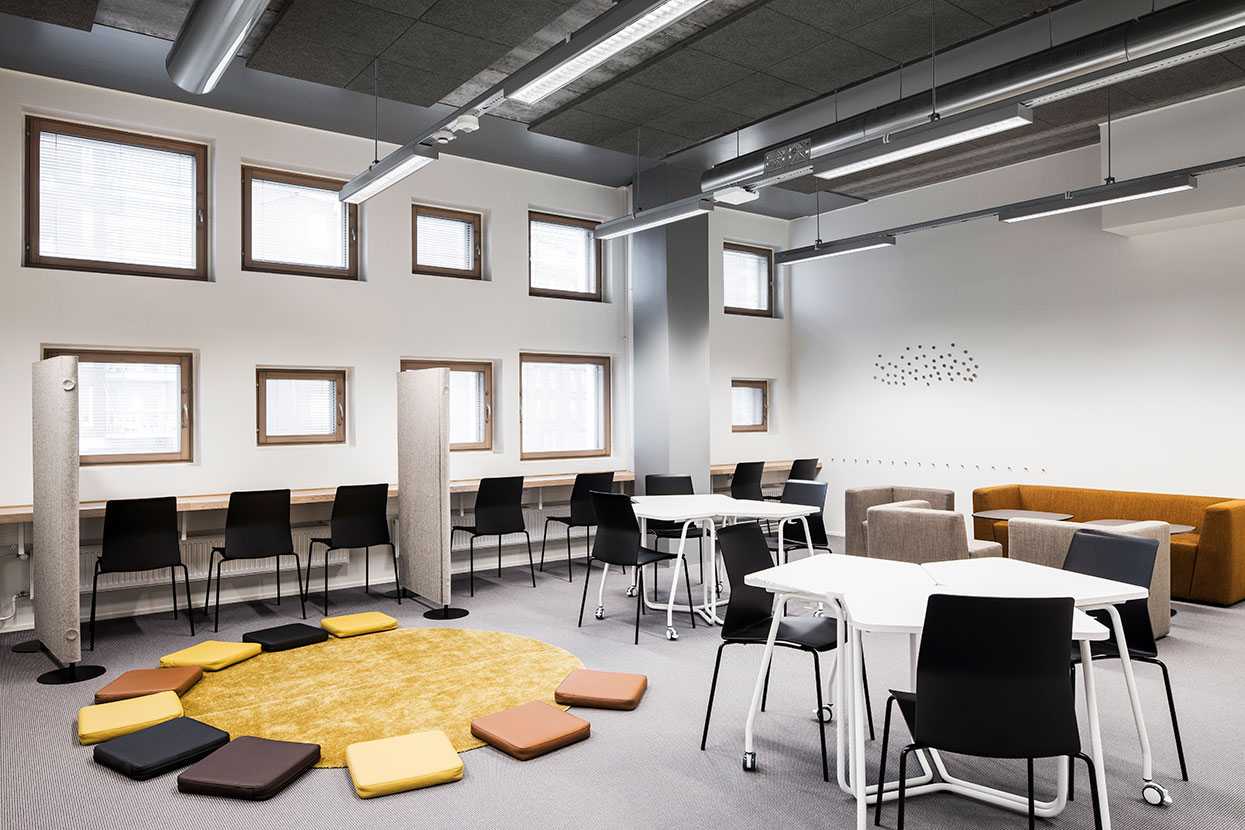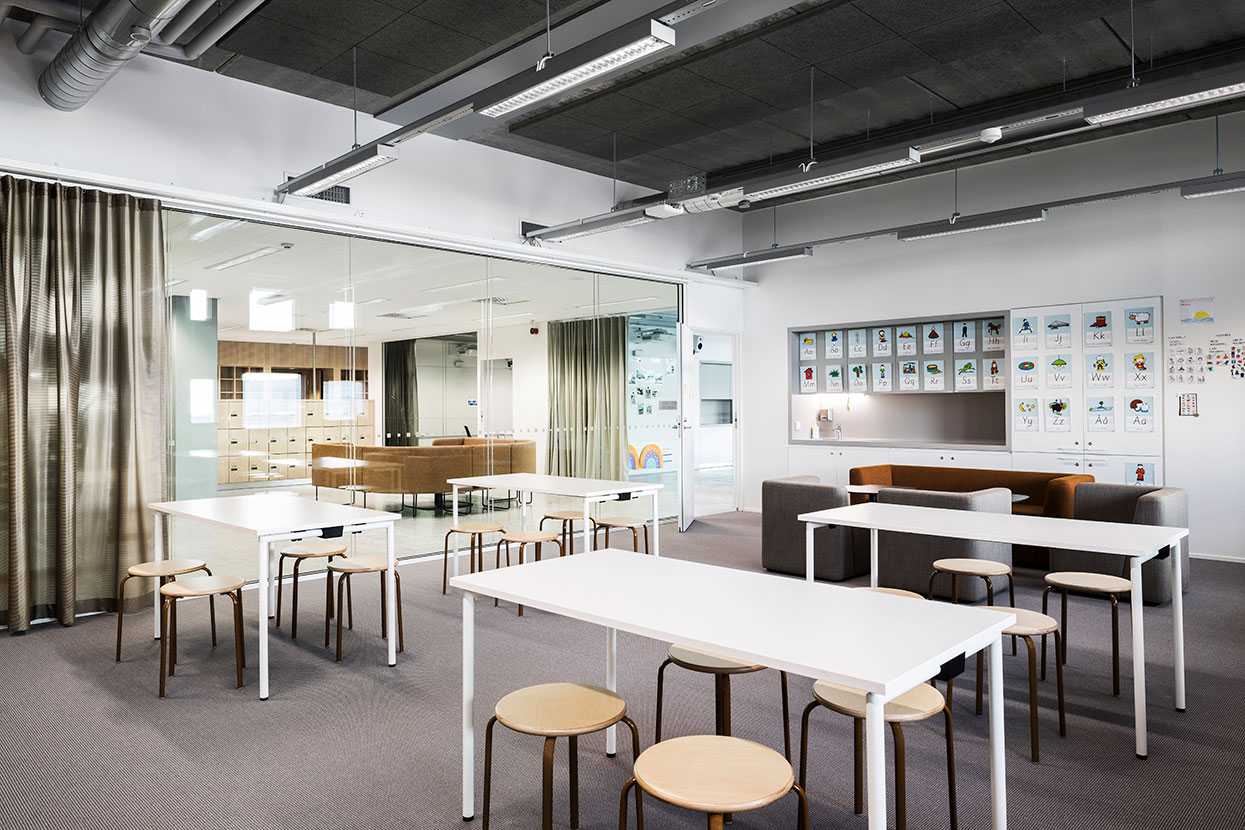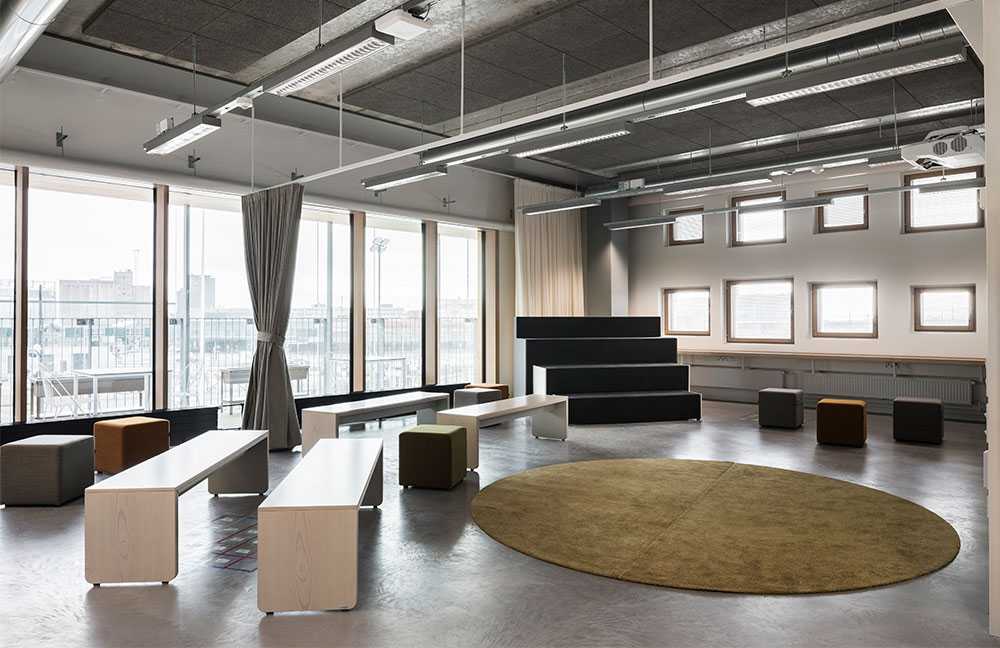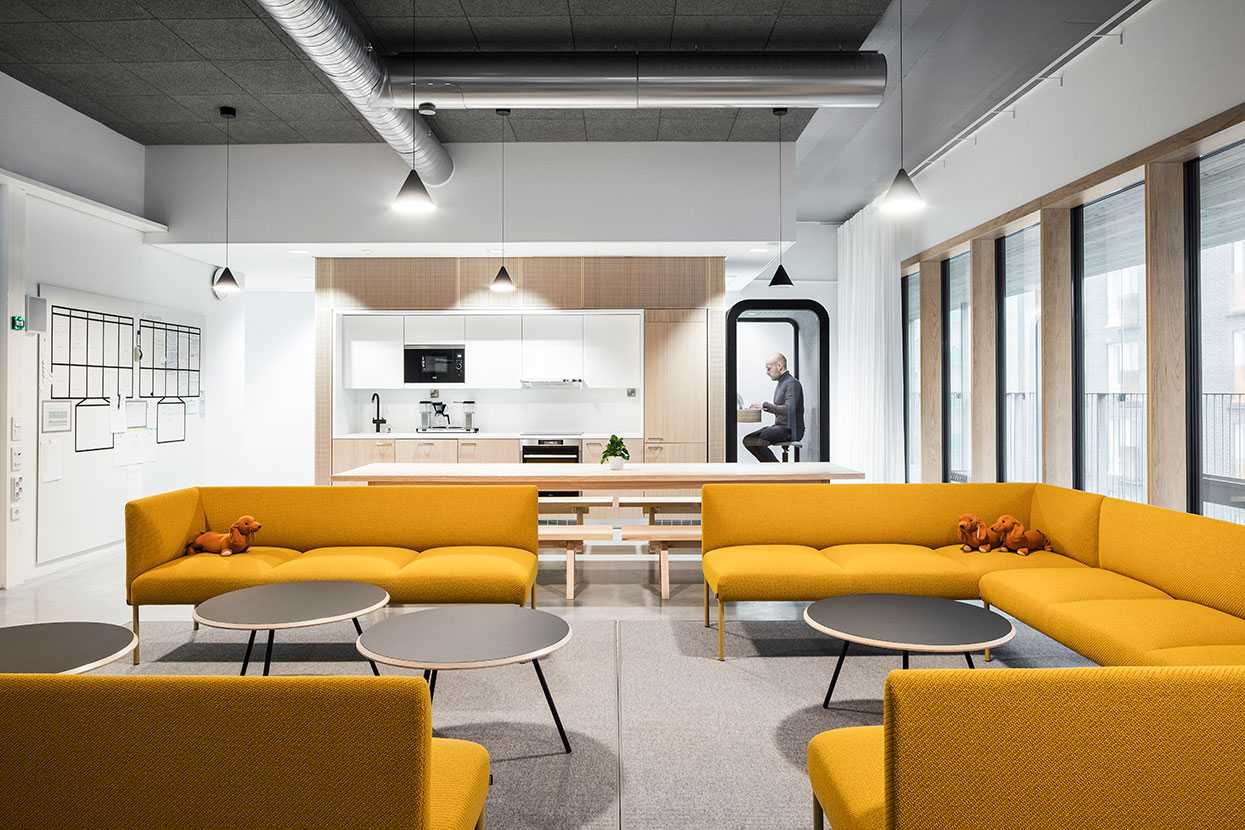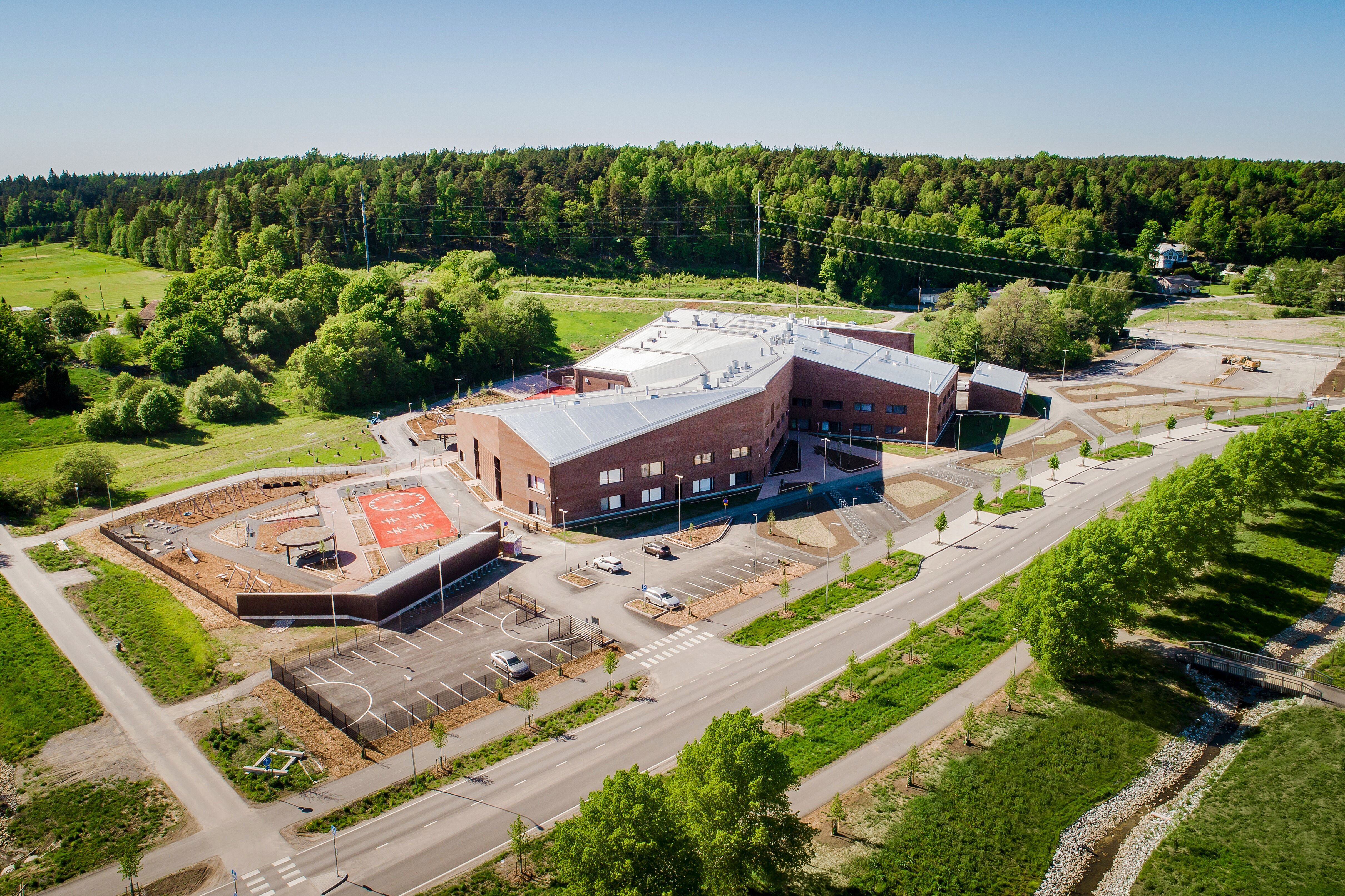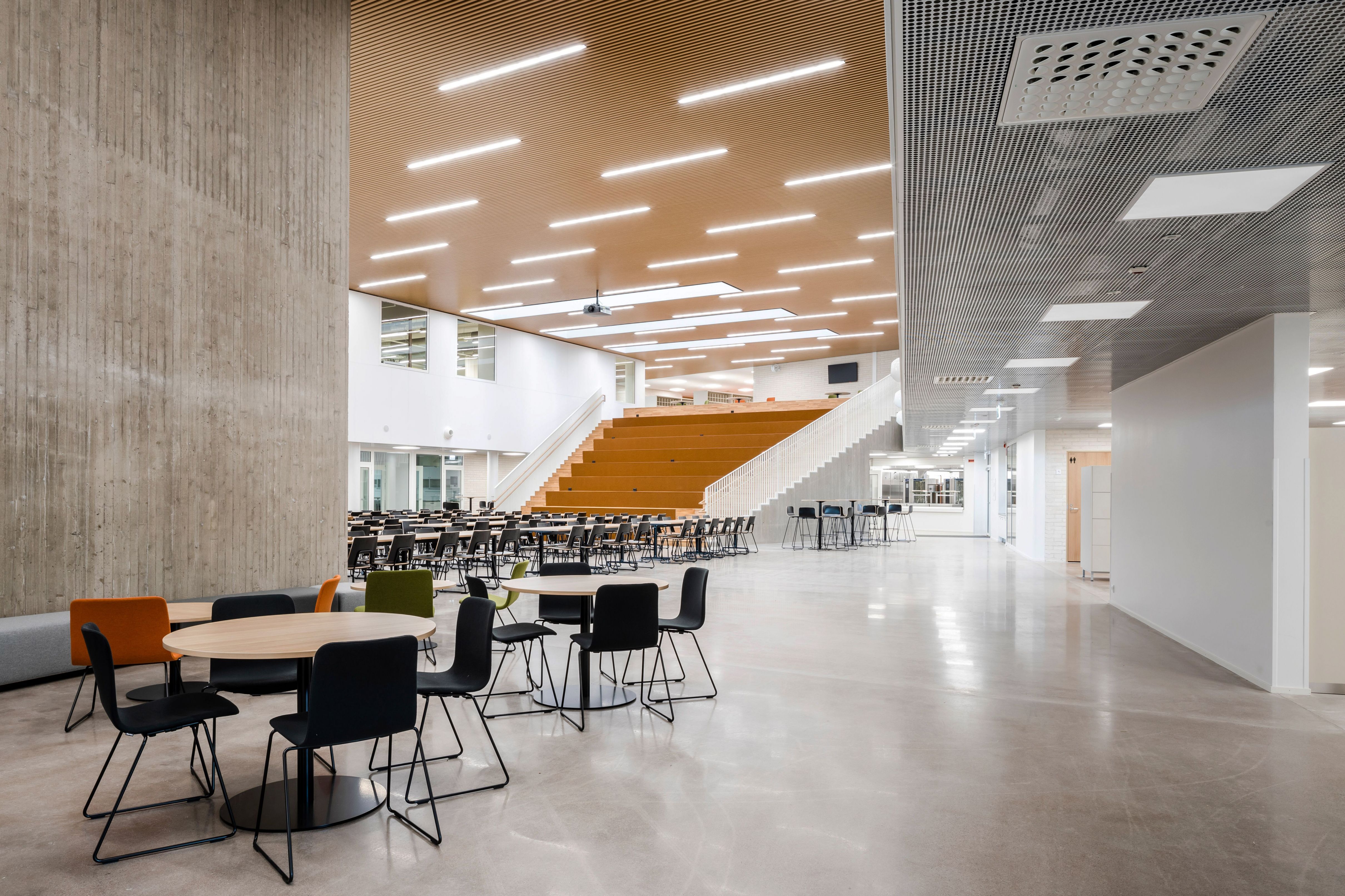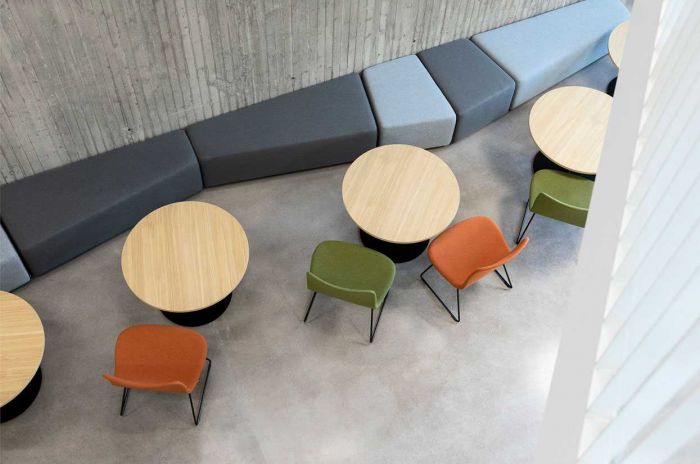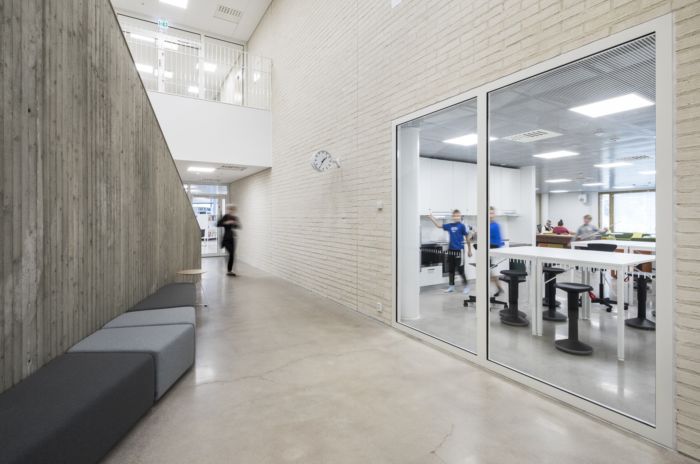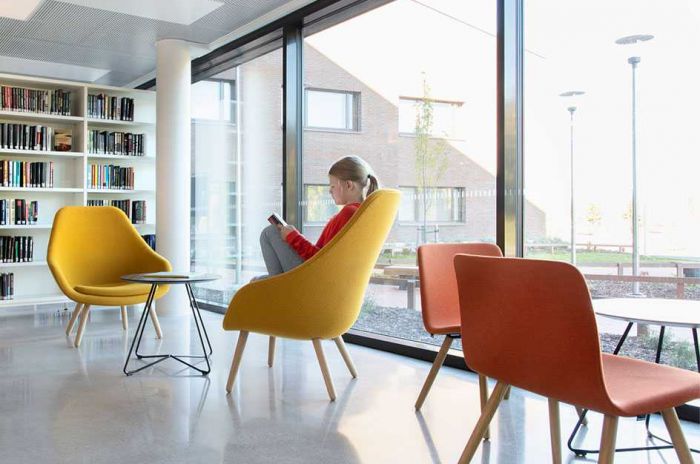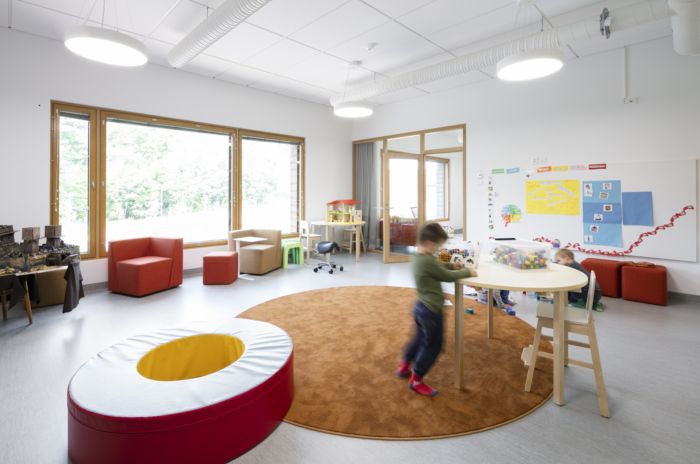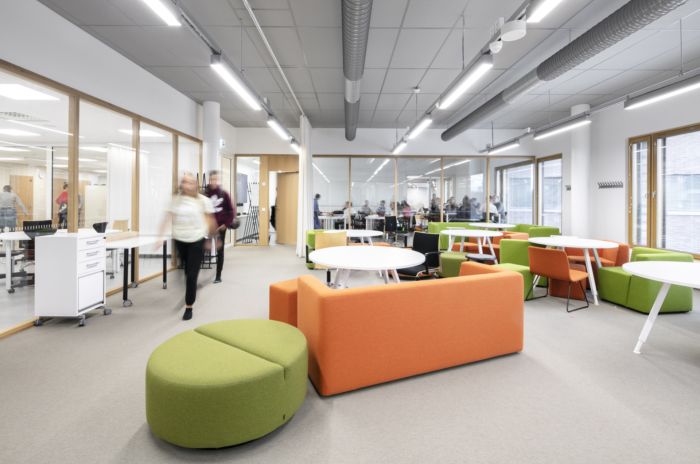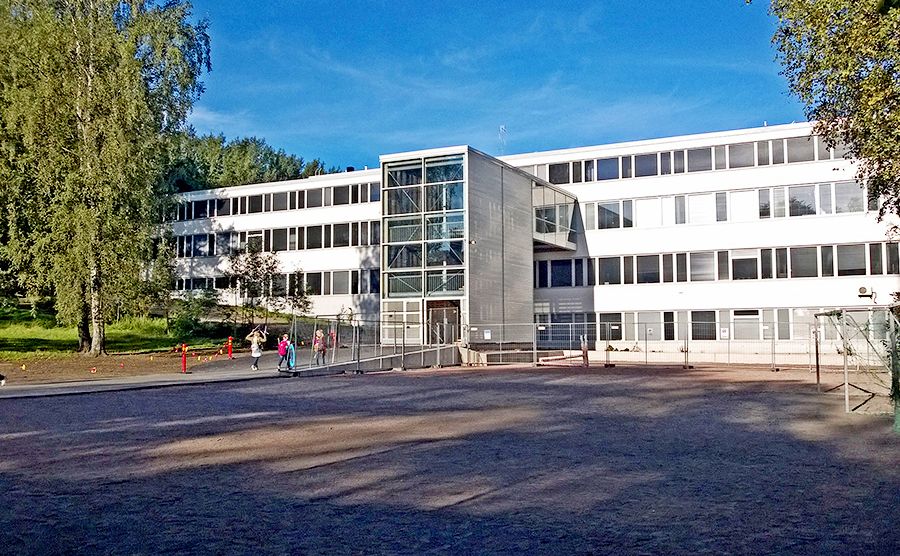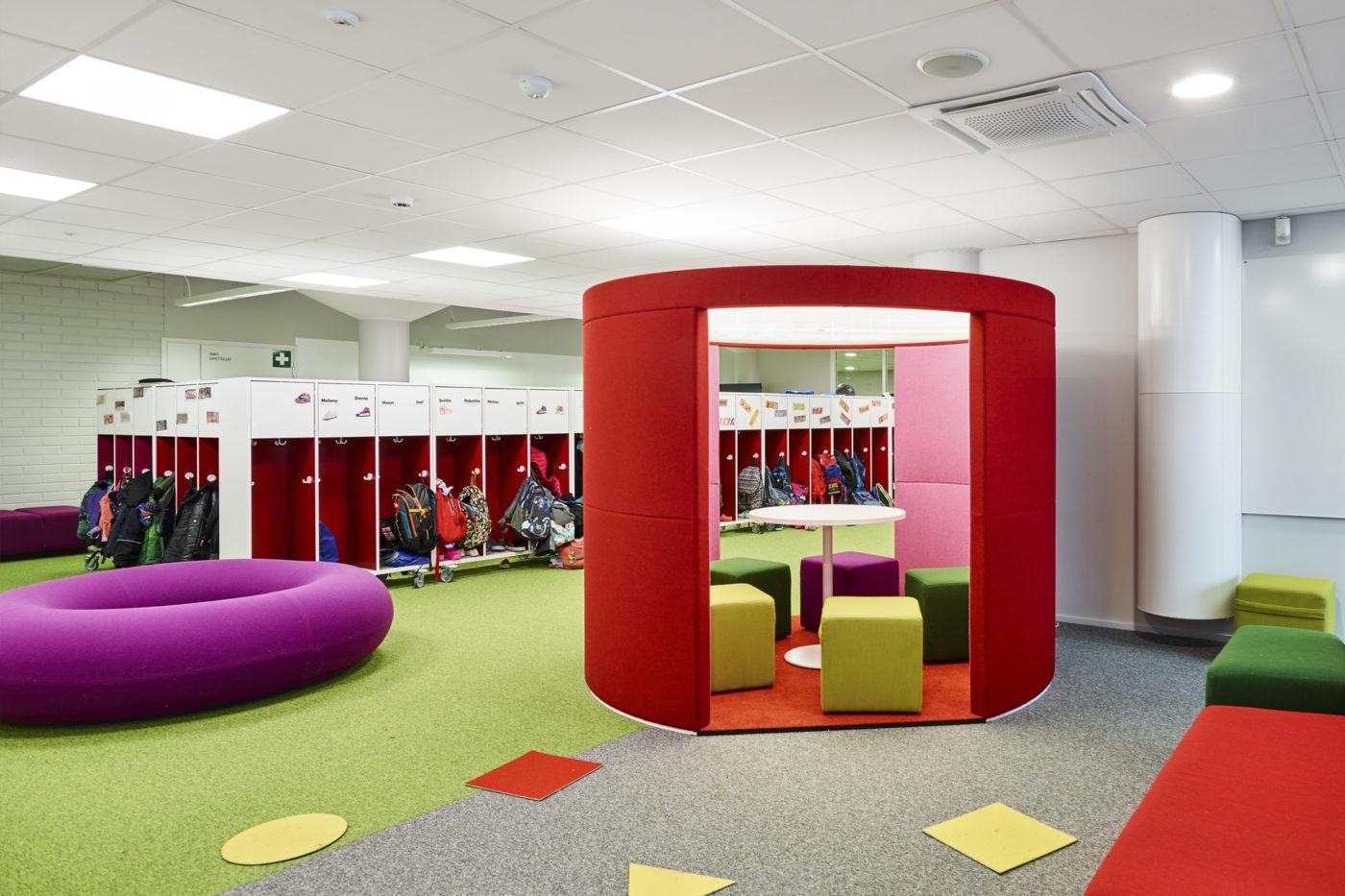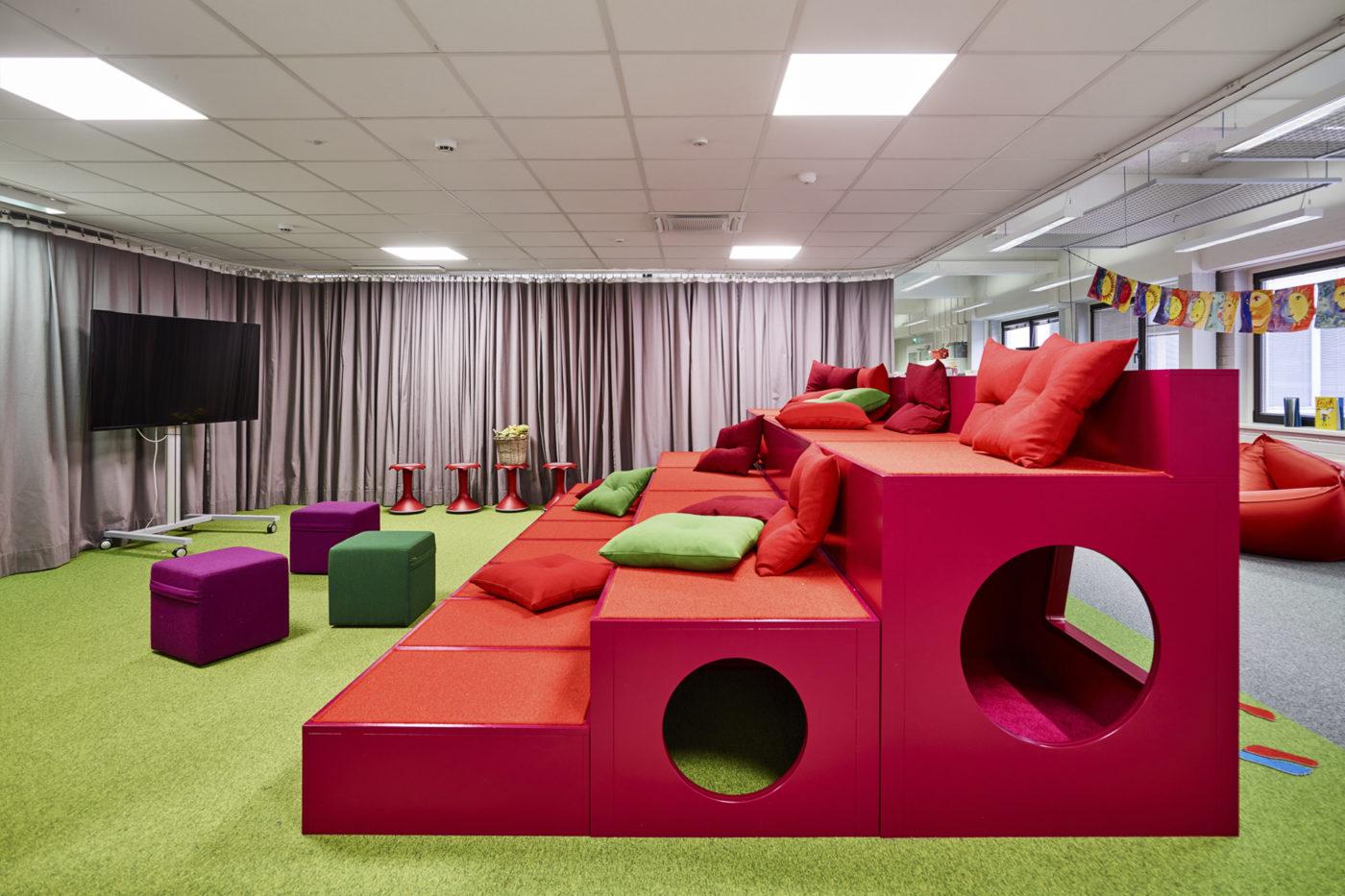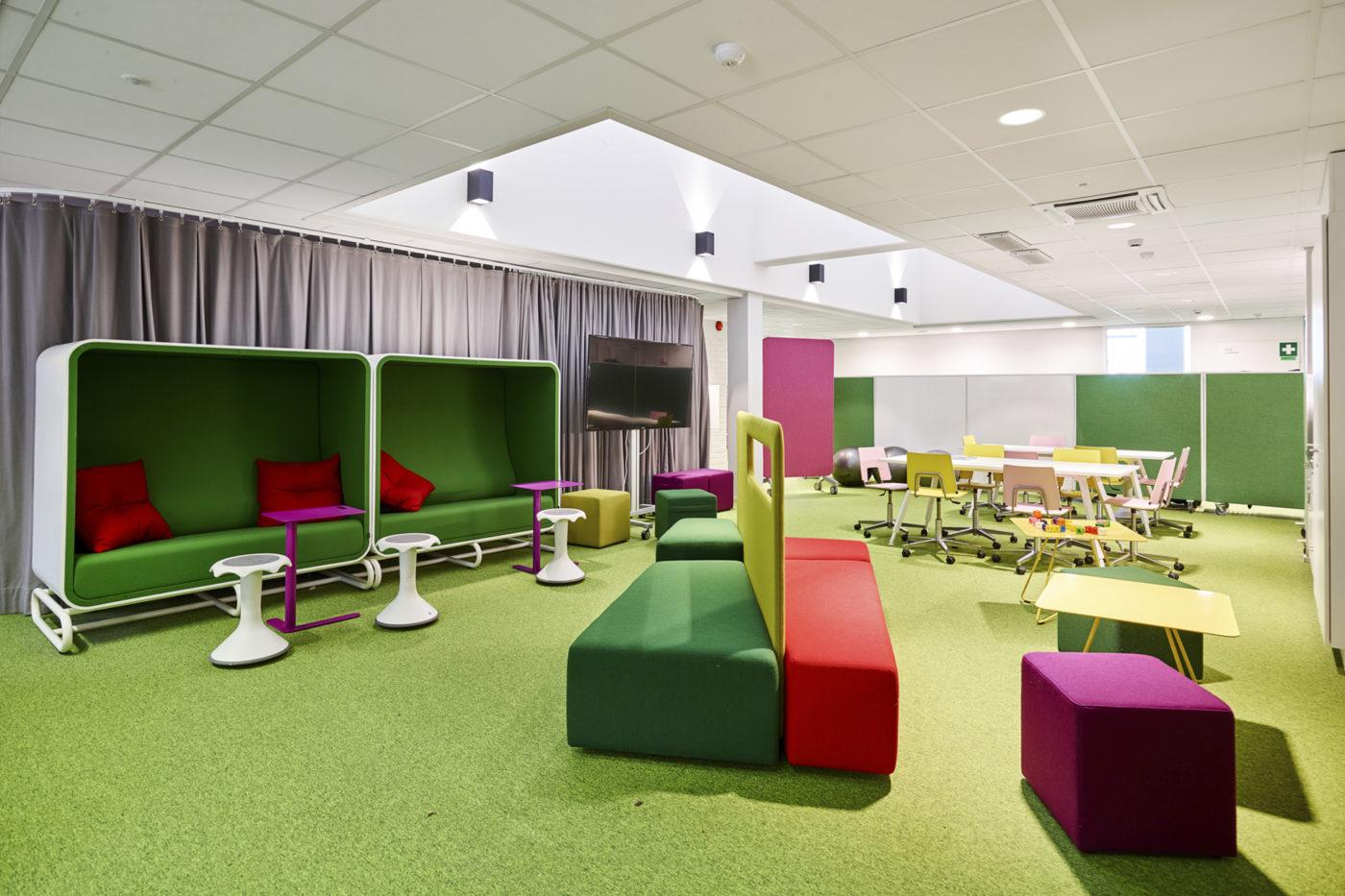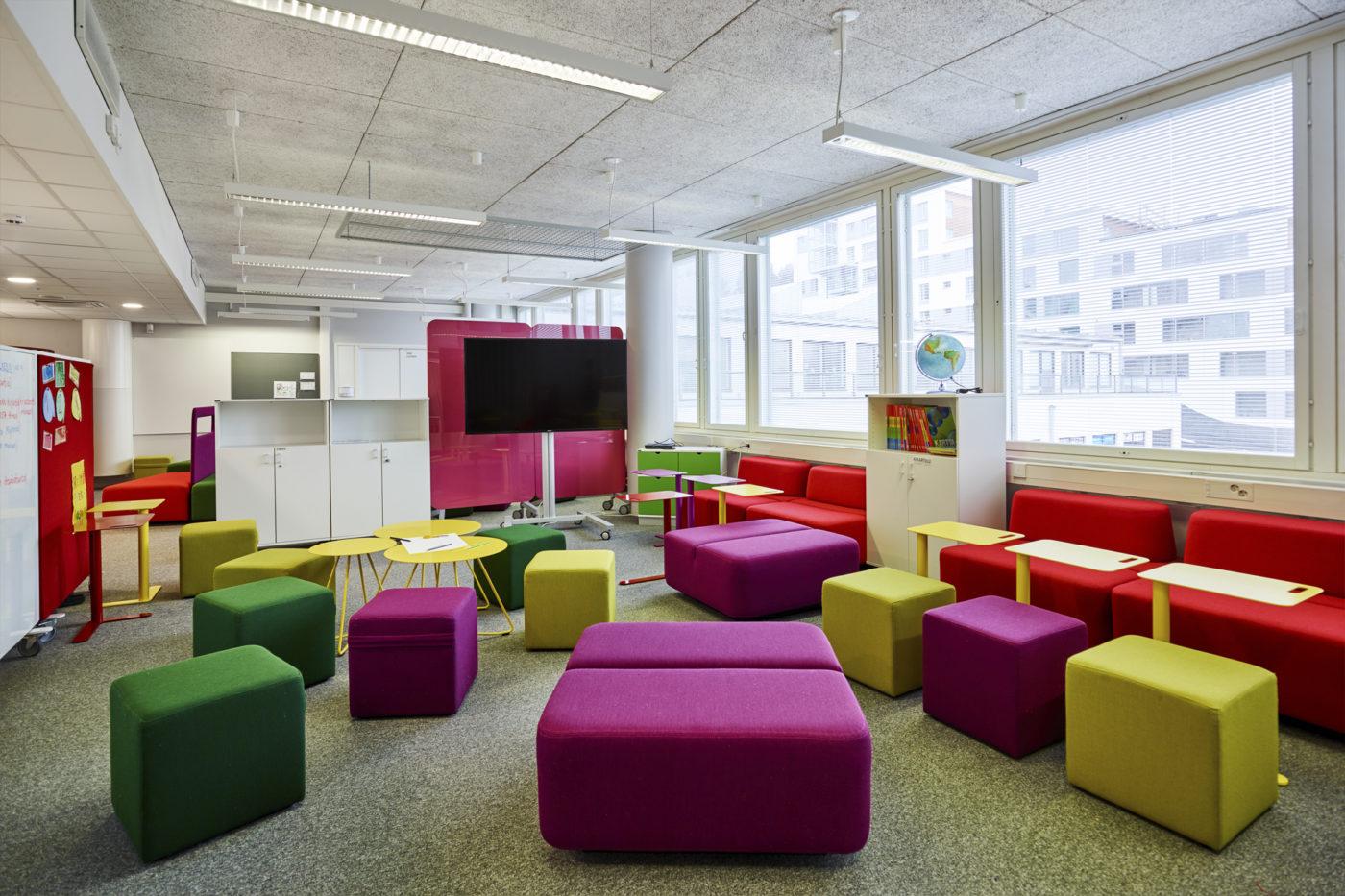New educational recommendations are constantly introduced in schools of Finland. The ideas of recent years include active participation of teachers and students in creation of schools starting from the stage of building design development; increased functionality of school buildings, so that they could be used not only for learning, but for integration into the social context as well: it is not a rare thing in Finland any more for a school to house a library, a youth center and a pregnancy follow-up medical office. We have visited three Finnish schools that can be considered most interesting nowadays to learn how they are arranged in terms of a curriculum and architecture, what scenarios of furniture use are behind the spaces.
School as an Environmental Development Center
photo: Pyry Kantonen; KUVIO
The Jätkäsaari School in Helsinki was opened in August 2019 amid a huge construction site. The school is on a peninsula in a new eponymous area which was decided to be transformed from industrial to the residential one. Only in 2007, there used to be a cargo port, a sorting depot and a trailer parking facility. Now, there is only a passenger terminal left from the former port, and the peninsula is lined with residential houses under construction and beautified.
It took a year to erect the building of the Jätkäsaari School; it was opened on August 1, 2019, as it is the day when the schoolyear starts in Finland. “It means that we all: teachers and students, and all the furniture, carpets, armchairs and so on found ourselves within these walls on August 1,” Kirsi Myllymäki, the school’s principal, comments. The unpacking process continued even weeks after the opening though, simultaneously with classes. “Parents and students took it in stride – they all live in our area, so construction can hardly surprise them,” Kirsi shares.
The Jätkäsaari district is built based on the environmental efficiency principles. Despite the surrounding construction that will take place until the end of 2020s, it is already well-greened. The garbage from the territory is taken to the central dropoff point through a noiseless underground vacuum system. There are no waste containers or garbage removal trucks – all the garbage is taken to the collectors at once. There are just a few roadways here, and the roads in residential blocks end with dead ends. A special area for pedestrians and cyclers is arranged where the port railroad used to be.
The teaching system of the school is also based on environmental principles: for example, in Math classes children calculate ways to use electricity and water efficiently. There are almost no paper books in the school. There are also few home-tasks that require reading a textbook – mostly children are involved in projects that need the Internet to be completed.
Kids don’t have their own textbooks at all: for example, there are only 20 textbooks of a subject for 60 second-graders. Starting from the 7 th grade, each student receives a laptop from school (or can use one of their own) where most educational materials are stored.
The works of a Finnish sculptor dedicated to the care of nature also remind about the environmental focus of the school – they are located within four large glass cubes through which daylight comes into the school premises.
What furniture is the school equipped with?
There is a lot of wooden furniture in Jätkäsaari, most of which is covered with perforated panels to reduce the acoustic noise level. There are special felt-lined cavities in the walls. These ‘nests’ are a result of architects’ consultations with the students themselves: at the design stage school interiors were recreated in the virtual reality, and children could introduce their ‘amendments’.
Aside from conventional chairs, there are stools and long benches without backs, as well as soft carpets and pillows. There are mobile amphitheaters for frontal work formats. Also, soundproof booths are provided for teachers, so that they could work in privacy.
photo: Pyry Kantonen; KUVIO
The industrial background determined some features of the school infrastructure: the gym at first was supposed to be in a so-called ‘bunker’ – the building of a former port warehouse. It is located across from the school and it’s so monumental that it was decided not to pull it down. The construction was supposed to be overbuilt with a residential complex and completed with a swimming pool and gyms on the lower floors. During learning hours the sport unit was supposed to be used by school, and in the evening it was to be open for residents of the district and the city, but the project is not implemented yet.
All the city buildings in Finland must fulfil as many functions as possible – that is the national-level rule. So, the central premise of the school – ‘market’ (it is synonymous to the word ‘square’ in Finnish) – also can be rented outside of learning hours. It can serve as a place for performances or dancing, or as a concert hall.
“Had I had an opportunity to change something in the school interior now, I would have added some small classrooms – the school is inclusive, there is no small amount of autistic children here that need such premises,” Kirsi Myllymäki shares. Now, there are large halls and hallways in school, separate classrooms – though always with transparent walls, so that it could be seen what happens inside.
School as a Place for the City Community to Meet
photo: Anders Portman
The Syvälahti School for 1,000 students is located in the suburb of Turku. Its opening in the autumn of 2018 caused quite a stir: residents of other districts and even cities started moving here, the area around the school was getting lined with buildings quickly, and the real estate was quickly sold out.
This school is a multi-functional center. Aside from the school, the building also houses a youth center, a nursery school, a local library and a medical office of a general practitioner specializing on follow-up of pregnant women and newborns. The establishments must interact: newborns will grow up to go to the nursery school, and then – to school. The playground for the nursery school located behind the school gradually transforms into a school yard, there are no separations between them (in Finland students always spend some of their breaks outdoors). “The benefit is that children can find themselves in a big company since an early age” Jarmo Salo, principal of the school, explains.
“Our premises are neither an experiment nor the only way the modern school can develop, it’s just another means of organization.” The latest recommendations of Finnish educational regulations approved in 2016 set the course for multi-functionality of schools. “However, the recommendations are only regarding the teaching and learning process, there are no rules in terms of how to build a school,” Jarmo explains. “And it’s very good,” he assures.
With 30 years of professional experience in teaching and educational project management, Jarmo Salo was engaged in the project of the new Syvälahti School in 2013. While the building was under construction, he practically lived on the site together with construction workers. “And let’s be honest, I have never worked so much in my life,” he says. Participation of the teaching staff in creation of the school is another recommendation of Finnish officials.
There are no hallways in the Syvälahti School, the learning spaces are arranged within four ‘blocks’ located around the central atrium. “When I look at the hallways of old schools with standard classes, I can’t see any difference between a school and a prison,” Jarmo Salo says.
During the classes children can sit on the floor or on the chairs of various heights. “It’s been known for a long time that it is harmful to stay in the same position the whole day,” Jarmo Salo explains. He himself does not work sitting on the floor: “I’m too old, it would be difficult for me to stand up,” the principal smiles. “There hasn’t been a chair in my office for 7 years already.” It is true: in his office (with glass walls just like in the rest premises of the school) there is only a high table with computers for him and his deputy. And some figurines of Darth Vader from Star Wars. “This is my idol,” Jarmo smiles.
“And if you think that there are no rules in the open places, you are woefully mistaken. The rules here might be even more strict than in conventional schools,” the principal says. The rules cover not only behavior in academic areas with various functions and allowable noise levels. There are, for instance, special regulations regarding mobile phones. Students of the 1st to 6th grades can use them in ‘loud’ public areas during the breaks, while in the classrooms and quiet working premises they must be put into their bags in a soundless mode. The rules for students of the 7th to 9th grades are even more strict: the children leave their phones in the ‘parking’ – they put the gadgets in special wooden boxes.
Computers in school are used only ‘when it is reasonable’. Here no one gives up paper textbooks in favor of digital. According to the principal, such an experiment used to be held in the neighboring school, but they returned to paper two years later: electronic textbooks are not that good yet.
What furniture is the school equipped with?
During the classes children can sit on the floor or on the chairs of various heights. There are soft portable modules in lower grades – comfortable stools to spin and even to rock while sitting.
Senior students leave their phones at the ‘parking’ during classes – they put them in special wooden modules. “Computers and gadgets in general are like a toilet. They need to be used when necessary. And, just like with a toilet, there need to be someone who instills order,” Jarmo Salo jokes.
photo: Anders Portman
There is a clear curriculum set for a year ahead. It never changes during a school year, though some selective variations are possible: for example, if the class hasn’t been able to cover the topic, it is logical to transfer it to the next lesson. There is not a chance that a lesson might be replaced with some social activity like a rehearsal, a visit to the lecture of a famous person or a meeting with an official. “Who should come to us for me to cancel the class?” Jarmo wonders. “Even if God himself comes, I’ll more likely make him sit down at a desk than interrupt the lesson.”
The changes can be introduced into the school order though: they need to be articulated and sent to the principal. Any student can do this – for example, by making an appointment with a principal. Recently, such an initiative of a student resulted in a change of the break format. Jarmo Salo explains: “It would be strange not to listen to the kids’ opinions in the school where there are currently 650 students and only 43 teachers.”
Open-space School instead of an Office
Photo by Courtsey Jaskanen-Repo-Teranne Arkkitehdit Oy
“The idea behind the education is for every child who comes to school to be in the society all the time,” says Satu Hakulinen, ex-principal of the Lauttasaari School who took part in generation of the concept for educational open spaces for some of her classrooms.
The Lauttasaari School is the largest primary school in Finland; currently 1,700 children study here (44 classes). The school is located on the eponymous island the population of which has been rapidly growing over the last 15 years: “Annually only our school greeted 60–70 new students,” Satu Hakulinen says. While the residents of the district are waiting for construction of a new school to end (the opening is planned for autumn 2022), some students study in the brick office building of late 1980s across the road.
In 2016, the building belonged to the municipal authorities and stayed empty, so the Lauttasaari School rented the third floor of it. There is a separately built wide stairway leading to it (it is even covered in case of bad weather). The first two floors are still occupied with offices.
“We wish we could have more place, but even current rent is expensive for us,” Satu Hakulinen explains. The office building is owned by private individuals, and it takes about one third of the school budget (about 7 mln euros per year) to pay rent. However, according to the rent contract, the land lot across the school is for its use, it is united with the main school yard.
Architect Pirkko Kukkurainen was invited to rethink the office space with the school in mind, as she had been working with zoning, interior furnishing materials and their colors actively. The main colors of school premises are light: white ceilings and columns inherited from the offices, light grey walls. Colorful felt-lined furniture is like vibrant spots against the background. The school lacks natural light, so there are a lot of lighting fixtures of various formats.
The more functions these square meters take upon themselves, the better. For example, in the canteen students eat since 10 to 12 only; the rest of the time it is turned into a classroom. The gym is divided into two smaller ones with the curtains. When the festivities take place here, the curtain is lifted, and wall bars are brought from the vertical position into the horizontal one to make a stage.
There are various floor coatings of premises based on their functions. The spaces where people often work with water (those for painting, cooking or eating) have linoleum on the floor, while the rest are covered with hypoallergic carpet flooring.
The main problem of open spaces is noise. There can be up to 100 students having a class in the same premise. According to the local educational regulations, the minimal area required for such a number of kids is 55 to 98 sq. m. How can silence be ensured during the classes in an open-space school? “Children need clear rules,” Satu Hakulinen assures. The school teachers have developed an entire system of signs that allows showing the students in class that the noise level should be reduced or that they need to pass the premise where the lesson takes place quietly. There are spaces in the school where they can be loud and those where the silence should be maintained. There are earphones in classrooms that can be used by any child. School floor, ceiling and some walls are covered with acoustic insulation.
“When the architect of this space one came to visit, she was incredibly surprised to see four groups of 60 children in class,” Satu says. “At first she thought there was no one here, so quiet it was.”
What furniture is the school equipped with? Everything that can be moved moves. Tables, chairs, cabinets, screens and even cloth lockers – all these are equipped with rollers. They are often used to make a temporary classroom – the back of the cabinets is equipped with special cover that can be written on like on a blackboard.
There is an exit to the hallway from every classroom, so the kids may go there to work on some assignment – there are poufs, huge donut- like poufs, hammocks and soundproof booths everywhere.
photo: Innovarch
